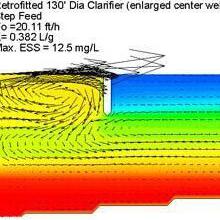Proven Benefits of WASSTRIP and OSTARA Technologies from Design Through Start Up
Last Modified Aug 02, 2022
The F. Wayne Hill Water Resources Center (FWHWRC) is Gwinnett County’s largest and most advanced wastewater treatment facility with a capacity of 60 mgd. The FWHWRC uses enhanced biological phosphorus removal and chemical trim to meet a TP limit. Solids handling includes anaerobic digestion of blended co-thickened primary sludge and waste activated sludge (WAS).
Over the past three years, struvite precipitation has increasingly become a major issue at the FWHWRC. Plant staff have used high pressure jetting of centrate lines in the past; however, struvite deposits are now being found in the dewatering centrifuges and upstream of dewatering. Struvite control, beyond reactive blasting and jetting of centrate lines, was needed moving forward. In addition, sludge from Gwinnett County’s 22 mgd Yellow River WRF is transferred to the FWHWRC resulting in significant additional phosphorus loading at the site further exacerbating phosphorus recycle loads in the future.
To address the struvite issues and decrease the impacts of phosphorus recycle loads on the main liquid stream, while at the same time creating a sustainable fertilizer through nutrient recovery, Gwinnett County selected the OSTARA Pearl® nutrient recovery process with WASSTRIP. The OSTARA Pearl® process creates controlled conditions of struvite precipitation for P and N recovery as a high quality fertilizer (Crystal Green®). The WASSTRIP process combines dewatered centrate with phosphorus and magnesium-rich WAS filtrate (from a WAS P-Release Reactor) into the Pearl® process, increasing Crystal Green® production and reducing struvite in solids handling.
This presentation will share results from start-up and more than eighteen months of operational data from the full scale facility. As of start-up on July 6, 2015, this facility is only the third full scale WASSTRIP installation in the United States. This case study will present the full-scale performance data of the WASSTRIP and nutrient recovery process, impacts on the main plant and solids handling processes, and lessons learned.
Full Scale Design
The Nutrient Recovery System consists of the following elements: WASSTRIP, nutrient recovery reactors, centrate and filtrate storage tanks, transfer pumps, fertilizer product handling system, and chemical feed systems. The WASSTRIP process consists of a holding tank where primary sludge and WAS are allowed to react anaerobically for approximately three to six hours. With the WAS concentration at the FWH facility averaging 12,000 to 15,000 mg/L and primary sludge at 30,000 mg/L, pre-thickening prior to the P release tank was not required. The combined sludge is then thickened by rotary drum thickeners and the filtrate which is phosphate and magnesium rich is stored as feed to the nutrient recovery reactors. Filtrate and centrate equalization tanks, plus one swing tank are 500,000 gallons each. The facility has two nutrient recovery reactors with space for a third one in the future. Each reactor has a nominal capacity of 4,400 pounds of struvite production daily.
To further prevent unwanted struvite accumulation, the design also included PVC centrate pipes with removable sections in the dewatering building, parallel HDPE centrate pipes into the recovery facility, and an acid feed loop to allow periodic cleaning of the feed pipes. The equalization tanks were designed to allow heavy solids to settle and include automatic draining and washdown.
Full Scale Performance
The FWHWRC nutrient recovery process is unique in that the utility adds Mg(OH)2 (mag) to the collection system for odor and corrosion control. High concentrations of soluble magnesium are found in the primary sludge due to the mag addition and therefore Mg does not need to be added to the Ostara process. The WASSTRIP tank is achieving good P-release with a HRT of 5 hours.
No impact to thickening, regarding polymer dose or thickened sludge concentration was observed. A summary of field testing of dewaterabiliity before and after WASSTRIP will be presented to determine any impact of WASSTRIP on dewaterability of the digested sludge. The actual dewatering cake solids has shown an increase since startup. While only preliminary, the data is encouraging and is one of the expected benefits of implementing WASSTRIP. In addition, nuisance struvite formation has decreased as the centrate pipes have not required high pressure blasting in the four months since startup. Plant metal salt use to achieve the very low TP limit of 0.08 mg/L has also decreased significantly, with alum usage in the biological system reducing from an average of 40 mg/L to 5 mg/L.
During the first four months of operation, the nutrient recovery system is averaging about 70 percent PO4-P removal and produced on average 1 ton per day of Crystal Green® fertilizer. Total P removals were initially very low (29%) due to struvite fines production but has since improved through changes in operation up to 43%. Struvite fines loss is a critical issue, since the fines are returned to the head of the plant and will dissolve, increasing the P load on the biological system. On-going optimization efforts to further increase the P-removal will be presented.
Additional discussion to be presented will include startup and operational issues including the unexpected growth of nuisance fungus (essentially floating mushrooms) growing on the water surface of the filtrate equalization tank. Actual cost savings and revenue generation will be compared to the business case evaluation conducted for this project. As this is only the third WASSTRIP installation in the U.S., the operational data to be presented will be a valuable addition to the industry database on the potential of this technology.










